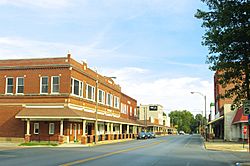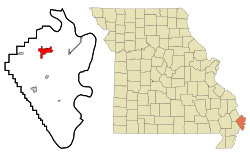Charleston, Missouri facts for kids
Quick facts for kids
Charleston, Missouri
|
|
|---|---|

Main Street
|
|
| Nickname(s):
"Flower of the Bootheel"
|
|

Location in Mississippi County and the state of Missouri
|
|
| Country | United States |
| State | Missouri |
| County | Mississippi |
| Area | |
| • Total | 4.85 sq mi (12.56 km2) |
| • Land | 4.80 sq mi (12.42 km2) |
| • Water | 0.06 sq mi (0.14 km2) |
| Elevation | 322 ft (98 m) |
| Population
(2020)
|
|
| • Total | 5,056 |
| • Density | 1,054.21/sq mi (407.07/km2) |
| Time zone | UTC-6 (Central (CST)) |
| • Summer (DST) | UTC-5 (CDT) |
| ZIP code |
63834
|
| Area code(s) | 573 |
| FIPS code | 29-13366 |
| GNIS feature ID | 2393804 |
Charleston is a city in Mississippi County, Missouri, United States. The population was 5,056 at the 2020 census, down from 5,947 in 2010. It is the county seat of Mississippi County and is home to the Southeast Correctional Center.
History
Charleston is the largest town on the Missouri side near the confluence of the Mississippi and Ohio rivers. Its history has been tied to traffic on the rivers.
Settlement initially occurred on the north side, in what in 1805 was called "Matthews Prairie".
After purchasing 22.5 acres (91,000 m2) for $337, Joseph Moore laid out Charleston in 1837. Some say the community derives its name from nearby Charles Prairie, while others believe the name is a transfer from Charleston, South Carolina. In 1845, it was selected as the county seat. A post office named Charleston has been in operation since 1847.
The Civil War Battle of Charleston was fought on August 19, 1861. Killed in the battle were one Union soldier and thirteen Missouri State Guard soldiers.
On September 1, 1861, Confederate General M. Jeff Thompson robbed the Union Bank of Charleston. Thompson, who handed the cashier a note, gave the cashier an hour to get approval from superiors to give him keys to the vault. After receiving the money, he left a receipt for $57,000 and discovered later that only $56,000 was in the bags.
The city was the epicenter of the October 31, 1895, 5.9 Mfa earthquake on the New Madrid Seismic Zone. The quake damaged virtually every building in Charleston, creating sand volcanoes and cracking a pier on the Cairo Rail Bridge. Chimneys toppled as far away as St. Louis, Missouri; Memphis, Tennessee; Gadsden, Alabama; and Evansville, Indiana. The fate of specific buildings may also be traced by Sanborn maps that were produced of the town during this period. This was the largest quake since the 1812 New Madrid earthquake, which measured at 8.3 and was the biggest recorded quake in the contiguous United States. One of the most visible signs of the quake is located south of Charleston at Henson Lake, which was greatly expanded by the quake.
In 1901, the county courthouse was built. It was designed by J.B. Legg, who designed numerous buildings throughout Missouri, including the Gasconade and St. Charles County courthouses. On February 10, 1997, the courthouse was damaged by fire and was subsequently torn down.
The Southeast Correctional Center, is a maximum security state prison for men, and is located on the southernmost edge of the city.
Just south of Charleston is Missouri's largest American Flag mural. It was completed in 2024 by artist Ray Harvey of New Haven, Missouri. The mural is located on the property of Delta Growers Association and can be easily seen from Route 105.
The Hearnes Site, Missouri Pacific Depot, Moore House, McCutchen Theatre, and Jacob Swank House are listed on the National Register of Historic Places.
Geography
Charleston is situated in northern Mississippi County, 12 miles (19 km) west-southwest of the confluence of the Mississippi and Ohio rivers at Bird's Point. Interstate 57 passes through Charleston, connecting it with southern Illinois across the Mississippi River to the northeast, and Interstate 55 near Sikeston to the west. U.S. Route 62 and Missouri Route 105 intersect near downtown Charleston.
According to the U.S. Census Bureau, Charleston has a total area of 4.85 square miles (12.56 km2), of which 4.80 square miles (12.43 km2) are land and 0.06 square miles (0.16 km2), or 1.15%, are water.
Demographics
| Historical population | |||
|---|---|---|---|
| Census | Pop. | %± | |
| 1860 | 273 | — | |
| 1870 | 635 | 132.6% | |
| 1880 | 1,028 | 61.9% | |
| 1890 | 1,381 | 34.3% | |
| 1900 | 1,893 | 37.1% | |
| 1910 | 3,144 | 66.1% | |
| 1920 | 3,410 | 8.5% | |
| 1930 | 3,357 | −1.6% | |
| 1940 | 5,182 | 54.4% | |
| 1950 | 5,501 | 6.2% | |
| 1960 | 5,911 | 7.5% | |
| 1970 | 5,131 | −13.2% | |
| 1980 | 5,230 | 1.9% | |
| 1990 | 5,085 | −2.8% | |
| 2000 | 4,732 | −6.9% | |
| 2010 | 5,947 | 25.7% | |
| 2020 | 5,056 | −15.0% | |
| source: | |||
2020 census
| Race / Ethnicity (NH = Non-Hispanic) | Pop 2000 | Pop 2010 | Pop 2020 | % 2000 | % 2010 | % 2020 |
|---|---|---|---|---|---|---|
| White alone (NH) | 2,493 | 2,777 | 2,159 | 52.68% | 46.70% | 42.70% |
| Black or African American alone (NH) | 2,136 | 2,983 | 2,639 | 45.14% | 50.16% | 52.20% |
| Native American or Alaska Native alone (NH) | 2 | 2 | 9 | 0.04% | 0.03% | 0.18% |
| Asian alone (NH) | 13 | 14 | 13 | 0.27% | 0.24% | 0.26% |
| Pacific Islander alone (NH) | 0 | 0 | 0 | 0.00% | 0.00% | 0.00% |
| Other race alone (NH) | 1 | 8 | 25 | 0.02% | 0.13% | 0.49% |
| Mixed race or Multiracial (NH) | 35 | 57 | 122 | 0.74% | 0.96% | 2.41% |
| Hispanic or Latino (any race) | 52 | 106 | 89 | 1.10% | 1.78% | 1.76% |
| Total | 4,732 | 5,947 | 5,056 | 100.00% | 100.00% | 100.00% |
2010 census
As of the census of 2010, there were 5,947 people, 1,705 households, and 1,107 families residing in the city. The population density was 1,239.0 inhabitants per square mile (478.4/km2). There were 1,883 housing units at an average density of 392.3 per square mile (151.5/km2). The racial makeup of the city was 47.55% White, 50.45% Black or African American, 0.03% Native American, 0.32% Asian, 0.61% from other races, and 1.04% from two or more races. Hispanic or Latino of any race were 1.78% of the population.
There were 1,705 households, of which 35.4% had children under the age of 18 living with them, 35.5% were married couples living together, 25.3% had a female householder with no husband present, 4.2% had a male householder with no wife present, and 35.1% were non-families. 32.1% of all households were made up of individuals, and 11.6% had someone living alone who was 65 years of age or older. The average household size was 2.44 and the average family size was 3.05.
The median age in the city was 37.1 years. 20.3% of residents were under the age of 18; 9.6% were between the ages of 18 and 24; 32% were from 25 to 44; 26.4% were from 45 to 64; and 11.6% were 65 years of age or older. The gender makeup of the city was 61.3% male and 38.7% female.
Education
Charleston R-I School District operates one elementary school, one middle school, and Charleston High School. Charleston High School has won 12 state boys basketball championships, the most recent being in 2022.
Charleston has a public library, a branch of the Mississippi County Library District.
Notable people
- Charlie Babb, former NFL player for the Miami Dolphins
- Lanie Black, Missouri state legislator
- William H. Danforth, businessman
- Ricky Frazier, former basketball player
- Betty Cooper Hearnes, Missouri politician
- Warren E. Hearnes, former Missouri governor
- James Boon Lankershim, Los Angeles area landowner and real estate developer
- James Naile, baseball player for the St. Louis Cardinals
- Ernie Nevel, baseball player
- Kenny Rollins, basketball player
- Joseph J. Russell, former member of the State house of representatives in 1886–1890
- John E. Scott, former state senate president pro tempore
- Samuel "Bay" Taylor, Negro league baseball player
- Matt Whiteside, baseball player
See also
 In Spanish: Charleston (Misuri) para niños
In Spanish: Charleston (Misuri) para niños

